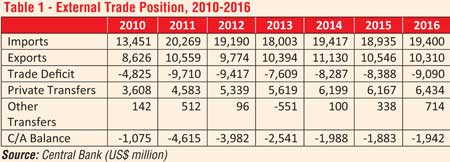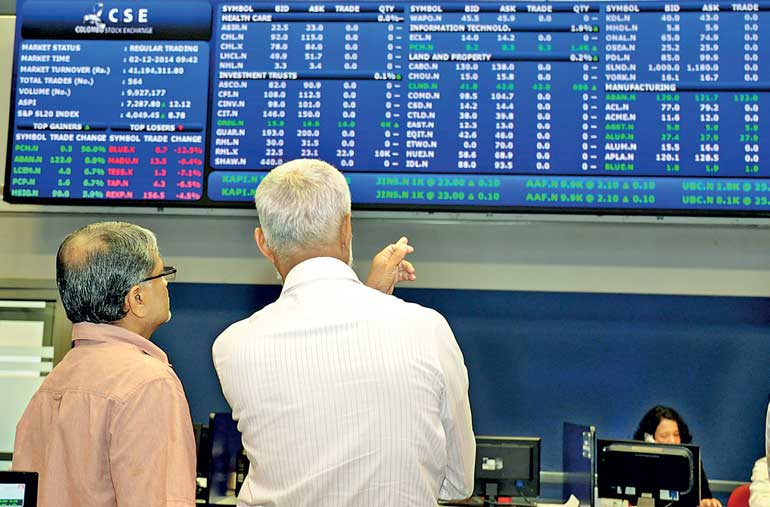Saturday Dec 06, 2025
Saturday Dec 06, 2025
Monday, 24 July 2017 22:39 - - {{hitsCtrl.values.hits}}
There is some confidence in the economy as reflected in the sales or turnaround in the Colombo Stock Exchange (CSE) during the first six months of this year, particularly the last three months.
Dropping 200 marks within the first three months, ASPI (All Share Price Index) has gained 700 marks by the end of June, the overall ASPI to be around 6,700. The situation is still below the 2010-2011 level, when suddenly the CSE became the best stock market in the world in 2010, which could not be sustained due to the tarnishing of its image through insider trading and other malpractices, sanctioned by the last regime.
If the situation is not to be cyclical, the Government must take more positive action in rejuvenating the economy. Confidence in the economy would boost the CSE, and confidence in the CSE would boost the economy. The approval of the GSP+ is another factor for a cautiously optimistic future. If this is utilised properly, that can uplift the economy to a great extent. This is not limited to garments, but there are over 6,000 goods covered under this preferential facility.
An added factor is the IMF’s approval of the third tranche of the Extended Fund Facility (EFF) of $ 167.2 million last week. It is hoped that with this grant, both the external reserve situation will be strengthened, and the exchange rate flexibility would be enhanced. This however is a loan and therefore it would increase the country’s external debt which is already high of around 34% of the GDP (out of overall 79%). Therefore, the rationale of this loan should be to increase the external revenue through exports, while debt servicing in the short run, without overwhelmingly depending on the remittances of the expatriate labour.
Imbalances in external trade
We do have a lopsided situation in respect of our external (free) trade that has been the case under all past regimes. Table 1 reveals the adverse situation.
Throughout years, we have had a considerable trade deficit and the situation has deteriorated since 2013. In that year, there had been an unexplained flight of at least $ 551 million funds out of the country, even if the ‘other inward transfers’ are counted as zero. Except in 2010, trade deficit has been around 85% of our exports. What this fact reveals is that we are an ‘import nation’ rather than an ‘export economy.’ In other words, Sri Lanka is a ‘consumer country’ rather than a ‘producer country.’
In 2016, for example, we have imported $ 19,400 million of goods but exported only 10,310 million worth. The exports are only around 53% of the total imports. What has come to our rescue is the private transfers, bulk of which is from the expatriate labour.
One can argue that expatriate labour is also an ‘export,’ but this is at a considerable human cost to the country both socially and economically. The country is increasingly facing shortages of skilled labour and also professionals. Of course, there are possibilities of ‘importing’ such labour from other countries, but the result would be the depletion of our foreign reserves, apart from other repercussions.
Even with our ‘export of labour,’ the country has not been able to foot the bill of our imports. The deficit in the current account (C/A) balance has been worst in the years 2011-2013 due to ‘political consumerism,’ but the situation has not yet improved; 2016 making a deficit of $ 1,942 million.
Policy requirements
In the above context, complete free trade is highly questionable at least in the short term, if not in the long run. The answer undoubtedly is not a closed economy, but nuanced policies to offset the imbalances. There is a need to restrict/discourage certain imports which exacerbate the deficit or harm the local small industries and agriculture.
Luxury vehicle importation is one, apart from completely scrapping of duty free vehicle licences for politicians and bureaucrats until the trade deficit is properly adjusted. Restrictions on liquor importation are another necessity. There can be higher tariffs for several other unnecessary goods coming into the country. Even in developed liberal countries, such measures are taken unless a country is within an open-border economic union (i.e. EU).
There should be some protection for the agricultural sector, particularly given the growth being negative, amounting to -4.2% during 2016. This cannot be attributed solely to natural disasters like droughts and/or floods. These calamities should be anticipated even in the future. This author could remember travelling to Jaffna by road before and after the open economy was inaugurated in 1977. A clear difference was the disappearance of plush agricultural fields, probably onion and chilies, between Vavuniya and towards Elephant Pass.
These sectors might not be resurrected, even with protection, as the war has changed the demography, occupations and life styles of the people in the Northern Province. However, there are peasants and farmers still in the Northern, Eastern, North Central, Uva, Southern and other provinces who need some care or protection for their agricultural products, until these sectors are modernised and made competitive with overseas markets. It is not total protection that is necessary, but nuanced safeguards.
What is more necessary are intermediary industries like Lanka Canneries (MD) or Larich that can convert some of the agricultural products into exportable goods, however assuring a reasonable price to the primary producers. If they were to reach the overseas markets, like China or the Middle East, the tastes could be milder. There is space for other competitors. I remember such products coming from Jaffna before the war and not sure whether they survived.
My emphasis on Jaffna or the north is that those economies have got devastated during the war, and resurrecting of them is necessary for both reconciliation and overall development. As I have previously suggested, there can be products like ‘Tea-Cola’ or ‘Mung-Mite’ like Vegemite or Marmite. It is a story in Australia that the growing middle classes in China even buying bottled ‘fresh air,’ as they have money to spend. Like the European markets under the GSP+, there can be market opportunities in China, Japan and India, even without strings!
Most of the above are opportunities, and not realities. To convert them to realities, it might be necessary to have a cautious approach without having wishful thinking, like ‘Miracles’ or ‘Megapolis.’ Because the present condition is more of a paradox than a clear progress. Instead of a western megapolis, what might be necessary in the country is a series of ‘smart cities’ surrounded by ‘happy villages.’
After the end of the war, there was an upsurge in the economy (2010-2012), but short lived. In 2012, the growth rate was 9.1%, which came down to 4.3 in 2013. The growth has not yet recovered to the required levels, the present administration also involved in too much politics, rather than economics. The growth rate last year was 4.4%. Although the growth rate is not the only indicator of economic progress or stagnation, it is a reasonable pointer.
Deficit in change
For the present situation to be assessed properly, certain political factors need to be considered. It was at the last moment that the so-called Yahapalana alliance was forged. Some of the consequences of that hasty or half-hearted formation are now visible. There were ideals and realities. There were genuine as well as opportunist elements behind the movement. The Government that became formed was a bicephalic (two-headed) animal, with the UNP and the SLFP.
The major deficit of the National Unity Government, in my opinion, is the absence of a viable economic policy. It is still ambiguous. Without such a policy, political reforms might be in jeopardy. In terms of the economic policy, what became declared was a ‘social market’ economy after suddenly coming into power. It is more of a concept or a vision than a concrete economic programme.
While both the UNP and the SLFP may agree for ‘social justice,’ in addition to economic development, particularly influenced by late Ven. Maduluwawe Sobitha Thero’s movement, still there can be differences on the issues of ‘private sector vs. State sector’ or ‘liberalisation vs social welfare.’ Maithripala Sirisena, as the Leader of the SLFP, has declared their policies to be ‘social democratic,’ whatever it means.
Why not have two engines?
After assuming duties, the current Minister of Finance, Mangala Samaraweera, declared the ‘engine of growth’ to be the private sector. This is a traditional UNP policy. However, there is a SLFP section in the Government with a different policy, although many of the old timers (including the old left) are still rotating around Mahinda Rajapaksa! Given the circumstances, or even otherwise, there is much rationale in having two engines – private and public – instead of one.
The traditions in Sri Lanka are more State-reliant. This may have to be changed or balanced, but not overturned. Take the example of SAITM issue. Already the Neville Fernando hospital is taken over (I wouldn’t say nationalised!). Sri Lanka may need to be pragmatic and take a middle path. Two engines may be better than one.
There is no question that the State sector is inefficient and corruptible. This must be changed. But who can say the private sector is not corruptible? Take the example of the bond issue. In the modern world, the same/similar ‘business excellence’ models apply to the private sector as well as to public sector. Sri Lanka should take a leaf out of these developments.

This is the critical last point. Prime Minister has announced a new wave of liberalisation by the next Budget 2018 (Daily FT, 20 July). That is all fine. A business-friendly environment is undoubtedly necessary to boost exports. Barriers to trade and productivity should be eliminated. Three-year economic policy statement would be unveiled, as reported. Although short of a ‘five-year economic plan,’ this is undoubtedly a welcome development. The PM has also not neglected the workers or the work force in his speech. He has also extended open arms to China, Japan and India while addressing the European Chamber of Commerce. That is the declared policy.
However, in the website of his Ministry of National Policy and Economic Affairs under ‘Economic Policy Statement’ the following is what appears as a preface.
“Our economic strategy is focused on interacting with this giant economy in the Indian Ocean. What we are hoping for is a lawful economic environment that will set the stage for sustainable development. Today our economy need no governance, yet a regulation. Prime Minister Ranil Wickremesinghe says that the aspiration for a prosperous country could be realised merely through more and more liberalisation of the economy.”
It could be a distortion by the webmaster. However, it implies the strategy is only focused on India! It is also more than ambiguous, when it says, “Today our economy need no governance, yet a regulation.” Through experience, it is obvious that ‘good governance’ is necessary both in the public and private sectors. It is also wishful thinking to say: “Aspiration for a prosperous country could be realised merely through more and more liberalisation of the economy.”
Necessary liberalisation is fine, but not to repeat things like bond scams. If the idea is to achieve prosperity ‘merely’ through liberalisation, it could also mean the complete neglect of the public sector, agriculture and welfare of the people. The Government needs to clarify these matters.

Confidence in the economy would boost the CSE, and confidence in the CSE would boost the economy